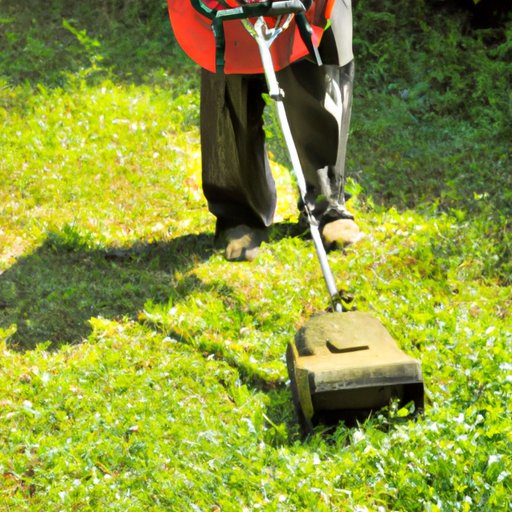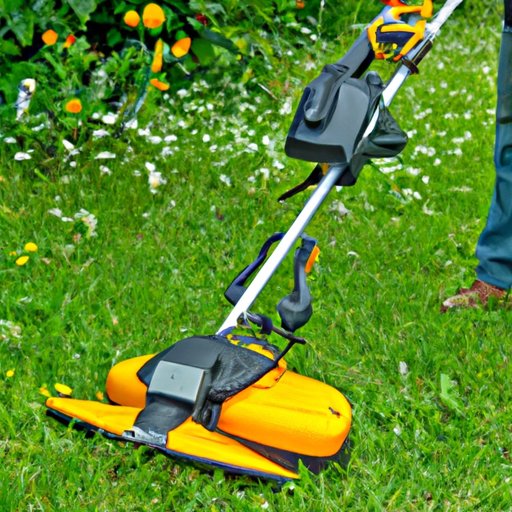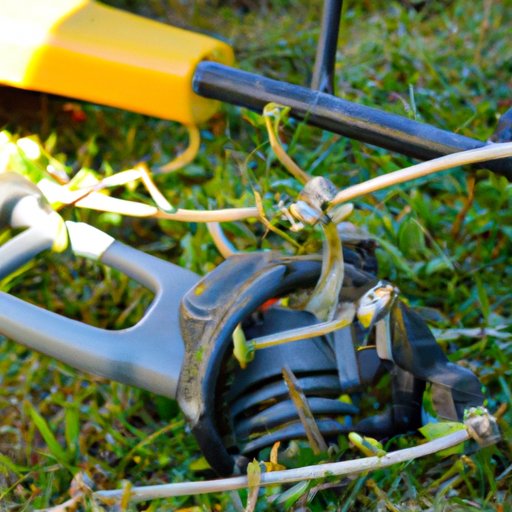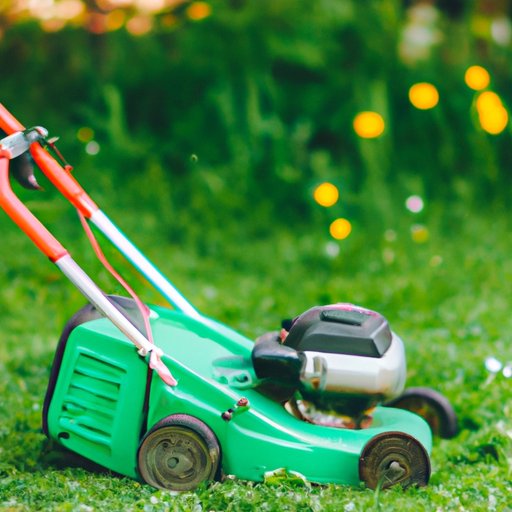Introduction
A weed eater (also known as a string trimmer, line trimmer or weed whip) is a power tool that uses a spinning nylon string to cut through vegetation such as grass and weeds in gardens and yards. This tool is an essential part of lawn maintenance, and can be used to reach difficult areas where a lawn mower cannot access. With the right knowledge and preparation, using a weed eater can be a simple and efficient task.

Overview of the Benefits of Using a Weed Eater
Weed eaters offer a number of benefits over traditional lawn mowing. According to research conducted by the University of Nebraska-Lincoln, “String trimmers are often used to trim around objects such as trees, fences, and driveways that are not easily mowed with a conventional lawn mower.” Additionally, weed eaters can also be used for edging, which gives lawns a neat and professional look. Furthermore, weed eaters are lightweight and easy to maneuver, making them ideal for smaller yards.
Step-by-Step Guide to Using a Weed Eater
Using a weed eater is a straightforward process, but it’s important to take the necessary safety precautions. The following steps provide a guide to using a weed eater safely and effectively:
Preparing the Weed Eater
Before starting the weed eater, make sure to read the user manual thoroughly. This will help you understand the various components of the tool, as well as the safety protocols for using it. It is also important to check that the weed eater is properly fuelled, and that all of the parts are in good working order.
Starting the Weed Eater
Once the weed eater is prepared, it is time to start it. To do this, simply pull the starter cord until the engine starts. Next, press the throttle trigger to engage the spinning string. At this point, the weed eater is ready to use.
Operating the Weed Eater
When operating the weed eater, hold it firmly with both hands and keep your arms close to your body. Start by cutting around the edges of the lawn, then move onto the center. Try to keep the spinning string at a consistent height and angle, and avoid pressing down too hard as this can cause damage to the tool. Finally, don’t forget to wear protective eyewear and ear protection while operating the weed eater.
Finishing Up
When you’re finished using the weed eater, turn off the engine and allow it to cool down before putting it away. Make sure to clean off any debris from the tool, and check that all of the parts are in good condition. Store the weed eater in a dry place, and ensure that it is out of reach of children.

How to Choose the Right Weed Eater for Your Yard
Choosing the right weed eater for your yard is essential for achieving the best results. Here are some considerations to keep in mind when buying a weed eater:
Considerations When Buying a Weed Eater
First, consider the size of your yard. If you have a small yard, a cordless electric weed eater may be a good option, as it is lightweight and easy to maneuver. On the other hand, if you have a larger yard, a gas-powered weed eater may be more suitable, as it offers more power and a longer running time. Additionally, consider the type of terrain you will be cutting, as some weed eaters are better suited for different surfaces.
Types of Weed Eaters
Weed eaters come in a variety of styles, including straight shaft, curved shaft, and wheeled. Straight shaft weed eaters are ideal for taller users, as they offer greater reach. Curved shaft weed eaters are lighter and more compact, making them easier to maneuver. Wheeled weed eaters are ideal for large yards, as they offer greater stability and require less effort to operate.
Tips for Maintaining Your Weed Eater
Maintaining your weed eater is key to ensuring that it lasts for many years. Here are some tips for keeping your weed eater in good condition:
Cleaning the Weed Eater
After each use, make sure to clean off any debris from the weed eater. This includes grass clippings, dirt, and oil. A soft brush can be used to remove any stuck-on debris from the tool.
Storing the Weed Eater
Store the weed eater in a dry place, such as a shed or garage. If possible, keep the tool elevated off the ground to prevent rusting and moisture damage.
Replacing Parts
Over time, certain parts of the weed eater may need to be replaced. The user manual should provide information on how to replace these parts. Additionally, it is important to check the air filter regularly, as a dirty air filter can reduce the performance of the weed eater.
Safety Precautions When Operating a Weed Eater
It is important to take the necessary safety precautions when operating a weed eater. Here are some tips for staying safe when using this tool:
Wear Appropriate Clothing and Gear
Make sure to wear long pants and closed-toed shoes when operating a weed eater. Additionally, it is important to wear protective eyewear and ear protection to avoid injury. Finally, it is recommended to wear gloves to protect your hands from the spinning string.
Be Aware of Surroundings
It is important to pay attention to your surroundings when operating a weed eater. Be aware of any obstacles such as rocks, sticks, and wires that could become entangled in the spinning string. Additionally, be aware of any animals or people that may be nearby.
Keep Children Away from Weed Eater
Finally, it is important to keep children away from the weed eater when it is in use. Store the tool in a secure location, and make sure that children know to stay away from it.

Troubleshooting Common Weed Eater Problems
If your weed eater is not performing as expected, there are a few simple troubleshooting steps you can take. Here are some tips for troubleshooting common weed eater problems:
Check Fuel Level
If the weed eater is having difficulty starting, first check the fuel level. Make sure that there is sufficient fuel in the tank, and that the fuel is fresh and not expired.
Check Spark Plug
The spark plug is responsible for igniting the fuel in the engine. If the weed eater is not starting, check the spark plug to make sure it is in good working order. If necessary, clean or replace the spark plug.
Inspect Air Filter
A dirty air filter can reduce the performance of the weed eater. Inspect the air filter to make sure it is clean, and replace it if necessary.
Check Carburetor
Finally, check the carburetor to make sure it is in good working order. Clean or adjust the carburetor if necessary.
Conclusion
Using a weed eater is a simple and efficient way to maintain lawns and gardens. By following the steps outlined in this guide, you can learn how to choose, use and maintain the right weed eater for your yard. Remember to take safety precautions when operating the tool, and be sure to inspect and maintain it regularly to ensure optimal performance.
(Note: Is this article not meeting your expectations? Do you have knowledge or insights to share? Unlock new opportunities and expand your reach by joining our authors team. Click Registration to join us and share your expertise with our readers.)
